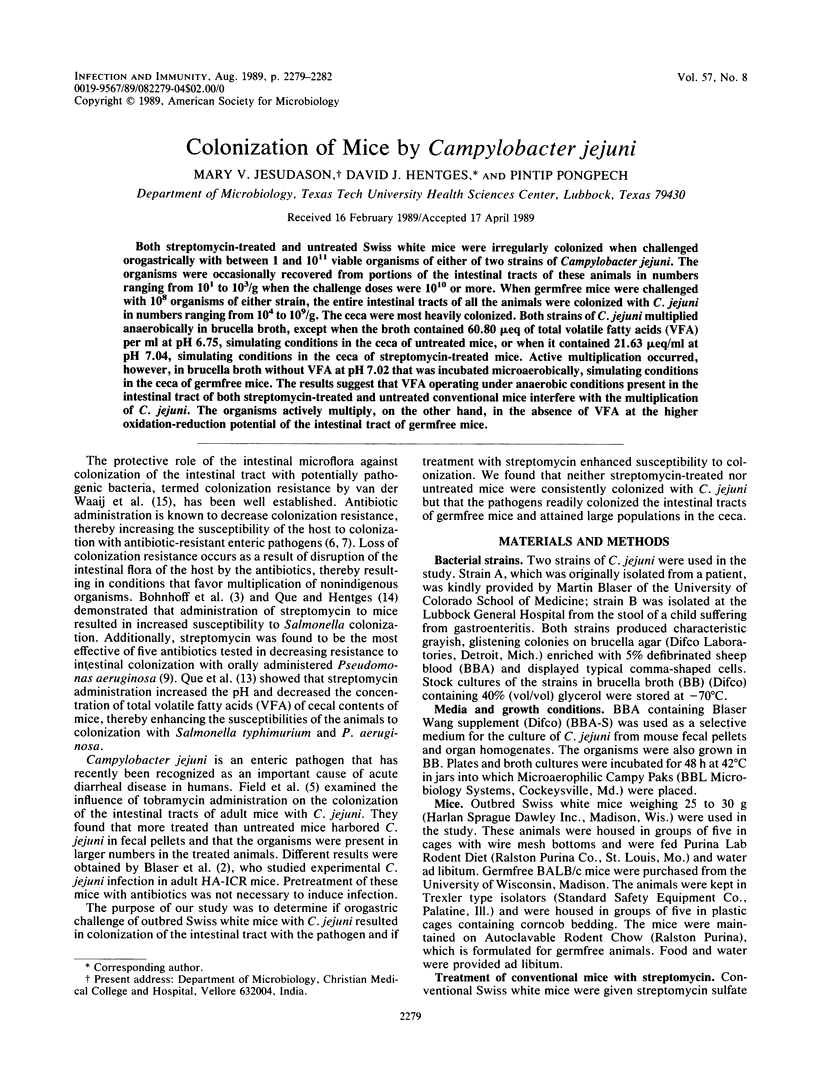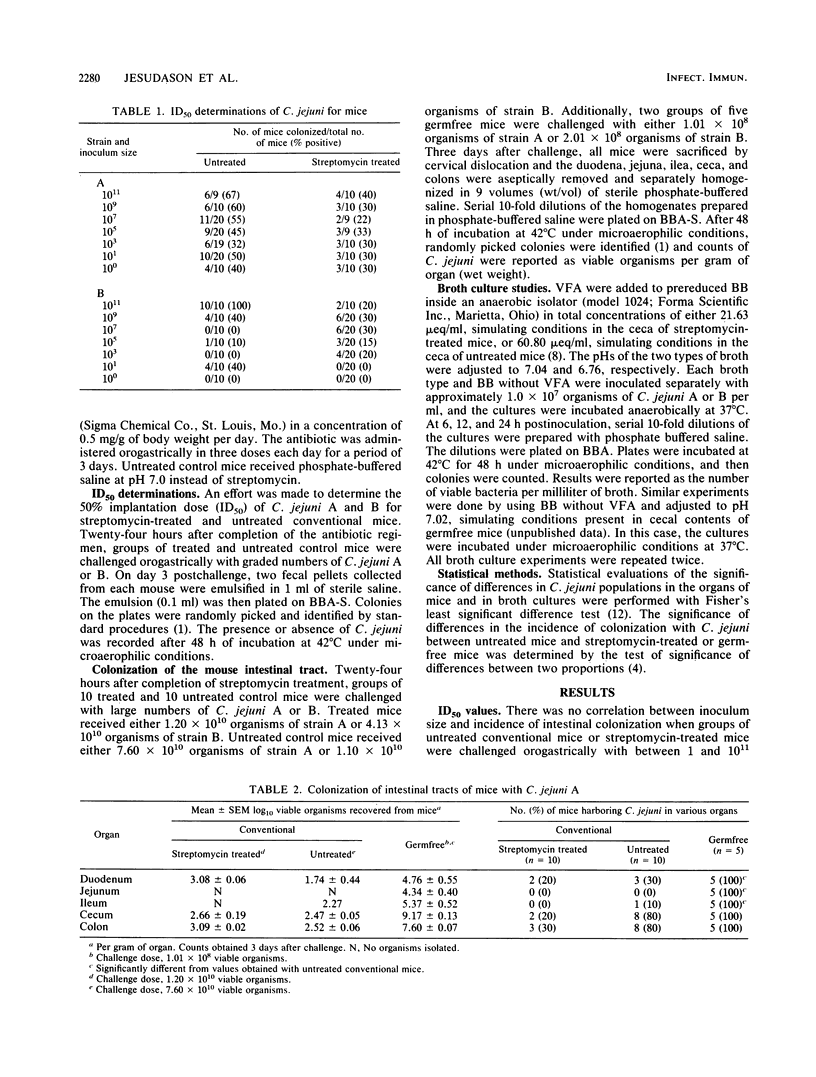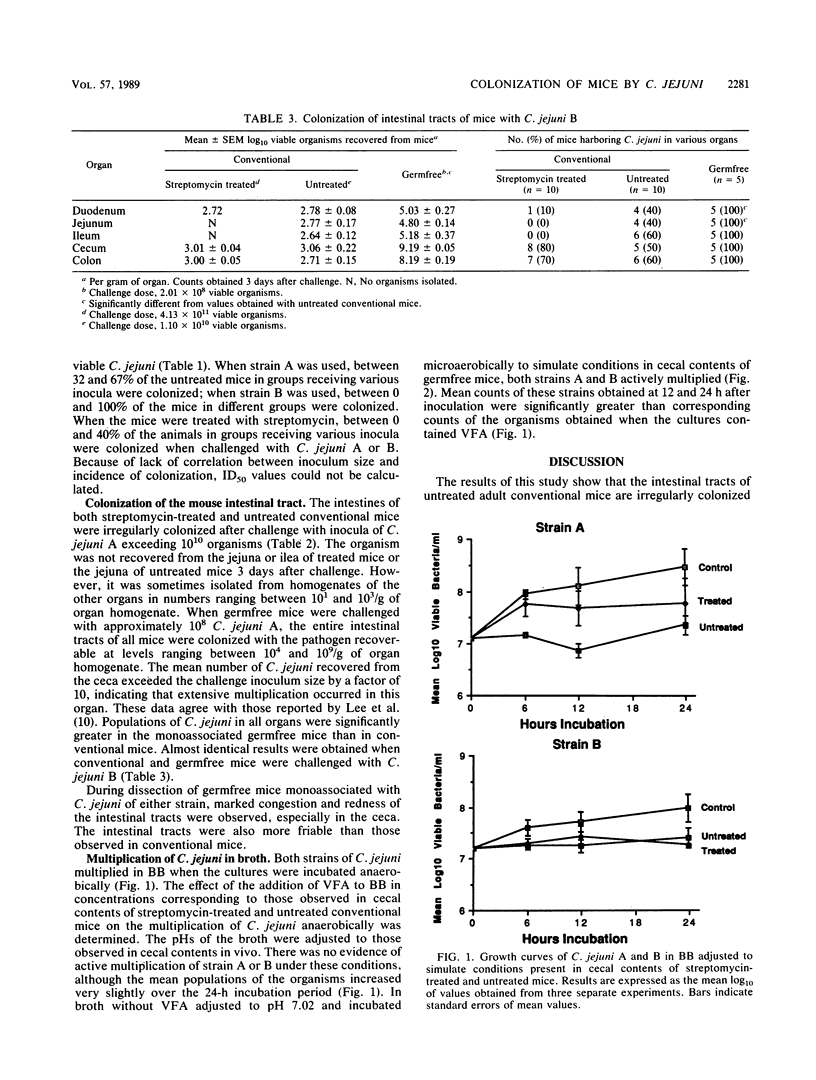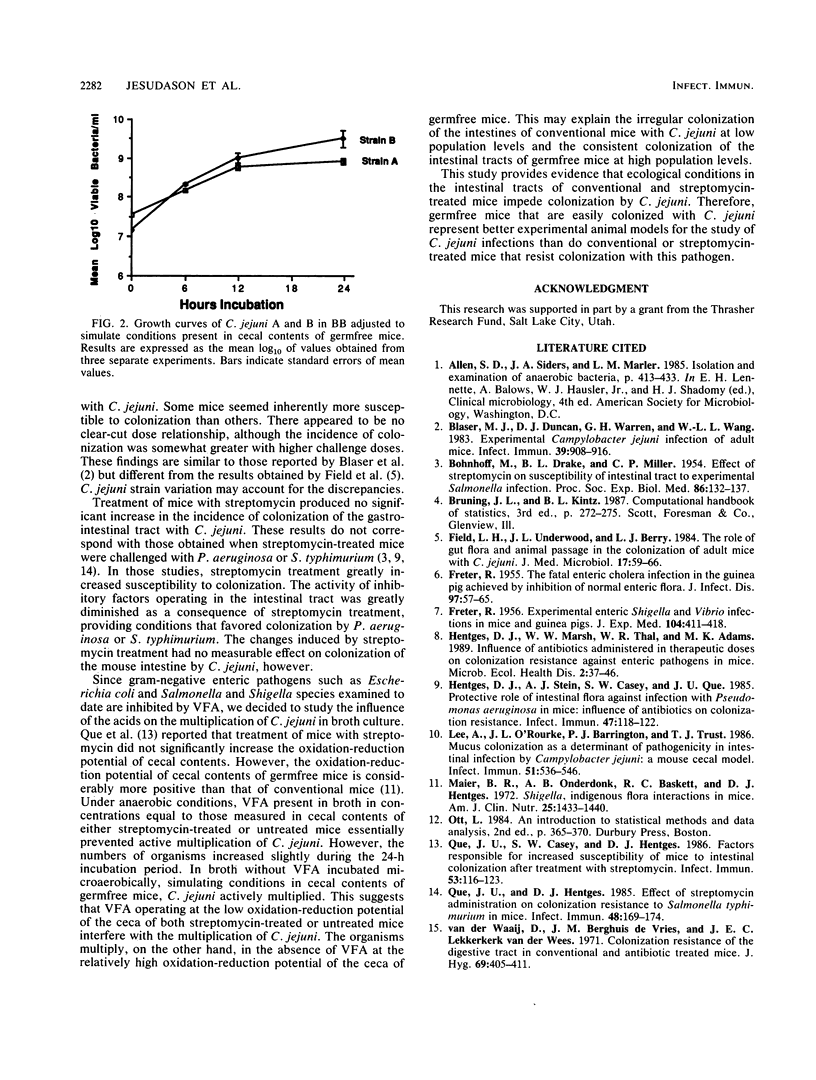Abstract
Both streptomycin-treated and untreated Swiss white mice were irregularly colonized when challenged orogastrically with between 1 and 10(11) viable organisms of either of two strains of Campylobacter jejuni. The organisms were occasionally recovered from portions of the intestinal tracts of these animals in numbers ranging from 10(1) to 10(3)/g when the challenge doses were 10(10) or more. When germfree mice were challenged with 10(8) organisms of either strain, the entire intestinal tracts of all the animals were colonized with C. jejuni in numbers ranging from 10(4) to 10(9)/g. The ceca were most heavily colonized. Both strains of C. jejuni multiplied anaerobically in brucella broth, except when the broth contained 60.80 mu eq of total volatile fatty acids (VFA) per ml at pH 6.75, simulating conditions in the ceca of untreated mice, or when it contained 21.63 mu eq/ml at pH 7.04, simulating conditions in the ceca of streptomycin-treated mice. Active multiplication occurred, however, in brucella broth without VFA at pH 7.02 that was incubated microaerobically, simulating conditions in the ceca of germfree mice. The results suggest that VFA operating under anaerobic conditions present in the intestinal tract of both streptomycin-treated and untreated conventional mice interfere with the multiplication of C. jejuni. The organisms actively multiply, on the other hand, in the absence of VFA at the higher oxidation-reduction potential of the intestinal tract of germfree mice.
Full text
PDF



Selected References
These references are in PubMed. This may not be the complete list of references from this article.
- BOHNHOFF M., DRAKE B. L., MILLER C. P. Effect of streptomycin on susceptibility of intestinal tract to experimental Salmonella infection. Proc Soc Exp Biol Med. 1954 May;86(1):132–137. doi: 10.3181/00379727-86-21030. [DOI] [PubMed] [Google Scholar]
- Blaser M. J., Duncan D. J., Warren G. H., Wang W. L. Experimental Campylobacter jejuni infection of adult mice. Infect Immun. 1983 Feb;39(2):908–916. doi: 10.1128/iai.39.2.908-916.1983. [DOI] [PMC free article] [PubMed] [Google Scholar]
- FRETER R. Experimental enteric Shigella and Vibrio infections in mice and guinea pigs. J Exp Med. 1956 Sep 1;104(3):411–418. doi: 10.1084/jem.104.3.411. [DOI] [PMC free article] [PubMed] [Google Scholar]
- FRETER R. The fatal enteric cholera infection in the guinea pig, achieved by inhibition of normal enteric flora. J Infect Dis. 1955 Jul-Aug;97(1):57–65. doi: 10.1093/infdis/97.1.57. [DOI] [PubMed] [Google Scholar]
- Field L. H., Underwood J. L., Berry L. J. The role of gut flora and animal passage in the colonisation of adult mice with Campylobacter jejuni. J Med Microbiol. 1984 Feb;17(1):59–66. doi: 10.1099/00222615-17-1-59. [DOI] [PubMed] [Google Scholar]
- Hentges D. J., Stein A. J., Casey S. W., Que J. U. Protective role of intestinal flora against infection with Pseudomonas aeruginosa in mice: influence of antibiotics on colonization resistance. Infect Immun. 1985 Jan;47(1):118–122. doi: 10.1128/iai.47.1.118-122.1985. [DOI] [PMC free article] [PubMed] [Google Scholar]
- Lee A., O'Rourke J. L., Barrington P. J., Trust T. J. Mucus colonization as a determinant of pathogenicity in intestinal infection by Campylobacter jejuni: a mouse cecal model. Infect Immun. 1986 Feb;51(2):536–546. doi: 10.1128/iai.51.2.536-546.1986. [DOI] [PMC free article] [PubMed] [Google Scholar]
- Maier B. R., Onderdonk A. B., Baskett R. C., Hentges D. J. Shigella, indigenous flora interactions in mice. Am J Clin Nutr. 1972 Dec;25(12):1433–1440. doi: 10.1093/ajcn/25.12.1433. [DOI] [PubMed] [Google Scholar]
- Que J. U., Casey S. W., Hentges D. J. Factors responsible for increased susceptibility of mice to intestinal colonization after treatment with streptomycin. Infect Immun. 1986 Jul;53(1):116–123. doi: 10.1128/iai.53.1.116-123.1986. [DOI] [PMC free article] [PubMed] [Google Scholar]
- Que J. U., Hentges D. J. Effect of streptomycin administration on colonization resistance to Salmonella typhimurium in mice. Infect Immun. 1985 Apr;48(1):169–174. doi: 10.1128/iai.48.1.169-174.1985. [DOI] [PMC free article] [PubMed] [Google Scholar]
- van der Waaij D., Berghuis-de Vries J. M., Lekkerkerk Lekkerkerk-v Colonization resistance of the digestive tract in conventional and antibiotic-treated mice. J Hyg (Lond) 1971 Sep;69(3):405–411. doi: 10.1017/s0022172400021653. [DOI] [PMC free article] [PubMed] [Google Scholar]


